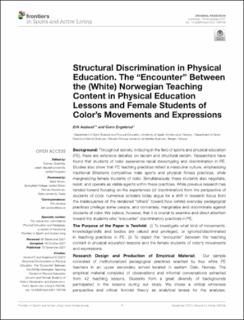| dc.description.abstract | Background: Throughout society, including in the field of sports and physical education (PE), there are extensive debates on racism and structural racism. Researchers have found that students of color experience racial stereotyping and discrimination in PE. Studies also show that PE teaching practices reflect a masculine culture, emphasizing traditional (Western) competitive male sports and physical fitness practices, while marginalizing female students of color. Simultaneously these students also negotiate, resist, and operate as visible agents within these practices. While previous research has tended toward focusing on the experiences (of discrimination) from the perspective of students of color, numerous scholars today argue for a shift in research focus from the inadequacies of the racialized “others” toward how (white) everyday pedagogical practices privilege some people, and conversely, marginalize and discriminate against students of color. We believe, however, that it is crucial to examine and direct attention toward the students who “encounter” discriminatory practices in PE.
The Purpose of the Paper is Twofold: (i) To investigate what kind of movements, knowledge/skills and bodies are valued and privileged, or ignored/discriminated in teaching practices in PE. (ii) To depict the “encounter” between the teaching content in physical education lessons and the female students of color's movements and expressions.
Research Design and Production of Empirical Material: Our sample consisted of institutionalized pedagogical practices enacted by four white PE teachers in an upper secondary school located in eastern Oslo, Norway. The empirical material consisted of observations and informal conversations extracted from 42 teaching lessons. Students from a great diversity of backgrounds participated in the lessons during our study. We chose a critical whiteness perspective and critical feminist theory as analytical lenses for the analyses.
Findings: Strenuous exercise as a means of becoming physically fit and “healthy” was central during the PE lessons under observation. The teacher's instructions draw on healthism discourses influenced by knowledge from exercise physiology and biomechanics, which produce a normative ideal for the body and movements in PE teaching practice. The movements and expressions of female students of color did not meet the expected norm of intensity, activity and exercises from the health and sport discourses. However, we identified female students of color as competent movers when performing “their own” movements, with which they had more of a cultural connection. These students also expressed vitality, joy and social interaction. Thus, they created new movements and expressions that contrasted with the norm of working out with a high intensity level in PE lessons.
Conclusion: Hegemonic “truths” about the body, physical exercise and health make teachers “blind” to the ways that institutionalized pedagogical practices in PE privilege majority ethnic white (male) students. Refusing to adhere to the institutionalized movement/exercise practices enacted by the teachers, the female students of color are competent dancers and express liveliness, spontaneity, and joy. In the future, incorporating these types of expressions to teaching practices can add value to PE. | en_US |

